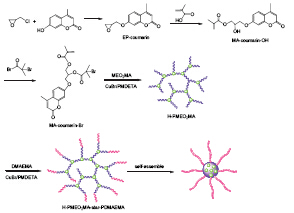| [1] Kienle, R. H.; Hovey, A. G. J. Am. Chem. Soc. 1929, 51, 509.
[2] Huang, T.; Wang, Z. Y.; Qin, A. J.; Sun, J. Z.; Tang, B. Z. Acta Chim. Sinica 2013, 71, 979 (黄田, 汪昭旸, 秦安军, 孙景志, 唐本忠, 化学学报, 2013, 71, 979.)
[3] Yan, D. Y.; Gao, C. Macromolecules 2000, 33, 7693.
[4] Zhang, L. Y.; Jiao, Q. Z.; Zhao, Y.; Zhou, M. J.; Feng, W.; Ge, Y. R. Acta Chim. Sinica 2011, 69, 2031. (张林雅, 矫庆泽, 赵芸, 周明吉, 冯薇, 葛艳蕊, 化学学报, 2011, 69, 2031.)
[5] You, Y. Z.; Hong, C. Y.; Pan, C. Y.; Wang, P. H. Adv. Mater. 2004, 16, 1953.
[6] Zhou, Y. F.; Yan, D. Y. Chem. Commun. 2009, 10, 1172.
[7] Vogt, A. P.; Sumerlin, B. S. Macromolecules 2008, 41, 7368.
[8] Semsarilar, M.; Ladmiral, V.; Perrier, S. Macromolecules 2010, 43, 1438.
[9] Tao, L.; Chou, W. C.; Tan, B. H.; Davis, T. P. Macromol. Biosci. 2010, 10, 632.
[10] Sheiko, S. S.; Gauthier, M.; Möller, M. Macromolecules 1997, 30, 2343.
[11] Tian, H. Y.; Deng, C.; Lin, H.; Sun, J. R.; Deng, M. X.; Chen, X. S.; Jing, X. B. Biomaterials 2005, 26, 4209.
[12] Lele, B. S.; Leroux, J. C. Polymer 2002, 43, 5595.
[13] Matyjaszewski, K.; Pyun, J.; Gaynor, S. G. Macromol. Rapid Commun. 1998, 19, 665.
[14] Zhang, W. J.; Fan, W.; Li, M.; Hong, C. Y.; Pan, C.Y. Acta Chim. Sinica 2012, 70, 1690. (张文建, 范溦, 李敏, 洪春雁, 潘才元, 化学学报, 2012, 70, 1690.)
[15] Shuai, X. T.; Merdan, T.; Schaper, A. K.; Xi, F.; Kissel, T. Bioconjugate Chem. 2004, 15, 441.
[16] Kakizawa, Y.; Harada, A.; Kataoka, K. Biomacromolecules 2001, 2, 491.
[17] Li, Y. L. Ph.D. Dissertation, Soochow University, Suzhou, 2010. (李玉玲, 博士论文, 苏州大学, 苏州, 2010.)
[18] Trenor, S. R.; Shultz, A. R.; Love, B. J.; Long, T. E. Chem. Rev. 2004, 104, 3059.
[19] Ling, J.; Rong, M. Z.; Zhang, M. Q. Chin. J. Polym. Sci. 2014, 32, 1286.
[20] Mal, N. K.; Fujiwara, M.; Tanaka, Y. Nature 2003, 421, 350.
[21] Jiang, J. Q.; Qi, B.; Lepage, M.; Zhao, Y. Macromolecules 2007, 40, 790.
[22] Jia, Z. F.; Zhou, Y. F.; Yan, D. Y. J. Polym. Sci. Part A: Polym. Chem. 2005, 43, 6534.
[23] Zhang, K. J.; Wang, J. L.; Subramanian, R.; Ye, Z. B.; Lu, J. M.; Yu, Q. Macromol. Rapid Commun. 2007, 28, 2185.
[24] Muthukrishnan, S.; Mori, H.; Müller, A. H. E. Macromolecules 2005, 38, 3108.
[25] Muthukrishnan, S.; Jultz, G.; André, X.; Mori, H.; Müller, A. H. E. Macromolecules 2005, 38, 9.
[26] Rikkou-Kalourkoti, M.; Matyjaszewski, K.; Patrickios, C. S. Macromolecules 2012, 45, 1313.
[27] Luzon, M.; Boyer, C.; Peinado, C.; Corrales, T.; Whittaker, M.; Tao, L.; Davis, T. J. Polym. Sci. Part A: Polym. Chem. 2010, 48, 2783.
[28] Gillies, E. R.; Jonsson, T. B.; Fréchet, J. M. J. J. Am. Chem. Soc. 2004, 126, 11936.
[30] Jiang, X. G.; Zhao, B. Macromolecules 2008, 41, 9366. |
